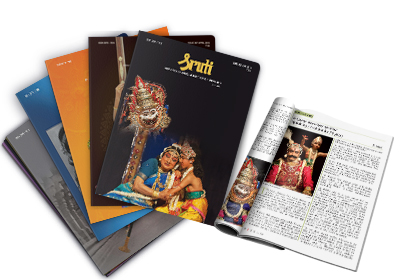Mahakavi Subramania Bharati

National Poet
Mahakavi Subramania Bharati
Subramania Bharati was a celebrated national poet of India. He ranks among the great bards of the world.
Commemorative Stamp
The Government of India honoured Subramania Bharati by issuing a commemorative stamp on his death anniversary on 11th September 1960. It was released at a special function in Madras by Dr. P. Subbarayan, who was the Union Minister of Transport and Communication.
The stamp was of 15 nP den., dark blue colour, perf. 13-1/2 x 14, water-mark "Lion Capital of Asoka" and was printed by photogravure process at India Security Press, Nasik. The stamp and the First Day Cover carry his portrait.
A brief biography
He was born on 11th December 1882 to Chinnaswamy Iyer and Laksmi at Ettayapuram, a small principality (zamin) in Tirunelveli District of Tamil Nadu. He was named Subramaniam, but was fondly called Subbiah. He lost his mother when he was five. It took a long time for him to recover from the shock. Indeed the loss of maternal love and affection lingered throughout his life.
Even as a child he was irresistibly drawn to poesy. He showed little interest in school studies. He proved his prowess in composing poems in complex metres and styles, and that too instantly (aasu kavi), at an assembly of poets in the Ettayapuram court, earning him the title Bharati (a synonym of Saraswati, goddess of learning). He was just eleven!
His father sent him to Tirunelveli for high school studies. Instead of attending schools, the lad spent time in holding discussions with Tamil scholars. Not surprisingly, he failed in the matriculation selection examination, and returned home.
In 1897, even while a student, he was married to Chellammal. He was fourteen and his bride, seven. His father died the next year. Now Bharati had to take care of two families at that young age.
He went to Banaras at the invitation of his aunt, continued his studies, passed matriculation, and obtained a degree as well. As usual, he also engaged himself in academic discussions with scholars and thinkers. He learned Sanskrit and Hindi, and developed a love for English poetry; Shelley was his favourite poet.
On his return to Ettayapuram in 1902, he was appointed a court poet, but he was not happy with the job. His first poem appeared in Vivekabhanu, published from Madras. By this time his first child was born and she was named Thankam.
In 1904 he served as a temporary teacher in Sethupathy College in Madurai. G. Subramania Aiyer, one of the founders of The Hindu, and editor of Swadesamitran, " a leading Tamil daily from Madras" came to know about the talented Bharati, and took him as his assistant editor. Simultaneously, Bharati also worked as executive editor of a magazine called Chakravartini.
Plunge into freedom struggle
The year 1905 saw him plunge into the national upheaval engendered by the partition of Bengal. He penned his first patriotic song Long may united Bengal live, and published it in Swadesamitran. He attended the Banaras session of the Indian National Congress held in 1905, and then the Calcutta session the next year. There he met (Sister) Nivedita Devi, an English disciple of Swami Vivekananda. That meeting made a deep and lasting impression on him.
He struck a deep friendship with V.O. Chidambaram Pillai (who was later to launch the Swadesi Steam Navigation Company), Mandayam Sreenivasachariar (he and his two brothers were known as the Pondicherry Brothers) and his cousin Tirumalachariar, Doraiswamy Iyer and industrialist Chakkarai Chettiar. They were ardent patriots and had made tremendous sacrifices in the freedom struggle. They were to stand by Bharati, through the most turbulent period that lay ahead. Tirumalachariar started a Tamil daily India in 1906, as also an English weekly Bala Bharata. Both were edited by Bharati.
Bharati attended the Surat session of the Congress in 1907, where he met Bal Gangadhar Tilak, Lala Lajpat Rai and Bipin Chandra Pal. The Bal-Lal-Pal troika represented the extremists group in the Congress. Bharati joined them.
Lawyer V. Krishnaswami, though known to be moderate, had Bharati first poems printed and distributed to schools, colleges and libraries free of cost. This was in 1907. In the next year, friends helped Bharati in publishing his first collection of poems Swadesa Songs. He dedicated it to Nivedita Devi.
Self-exile in Pondicherry
Bharati began emitting the fire of patriotism through his editorials in India and his powerful poetry. (Though Bharati was the editor of India, one N. Srinivasan had been the declared editor.) The government took fright, and arrested and imprisoned Srinivasan. It also issued a warrant against G. Subramania Aiyer. Bharati was next in the firing line. Heeding to the pleas of his friends and well-wishers, Bharati escaped to Pondicherry, then a French territory, leaving his daughter in the care of his aunt in Banaras. In the coming days Pondicherry was to become a safe haven for a host of freedom fighters. Bharati made acquaintance with Kuvalaiyur Krishnamachariar alias Kuvalai Kannan, who was to be of great help to the poet in the years to come.
Bharati continued to write for India as also for Vijaya (a daily), Sooryodayam (a weekly), Karmayogi (an English magazine) and Chitravali, a cartoon journal. Alarmed at the growing popularity of these journals the British Government banned them all. The redoubtable Sreenivasachariar dismantled the printing machines and carted them secretly to Pondicherry, and continued the publications! The British Government then imposed rigorous postal regulations in India and effectively stopped circulation of the publications. They also stopped the remittances of subscriptions. Soon, all the publications had to be closed down. Bharati journalistic activities also came to a halt.
During that period, Bharati's second daughter was born. He named her Sakuntala, as he was reading Kalidasa's celebrated work Abhijnana Sakuntalam when the child arrived.
Bharati brought out his second collection of songs Janmabhoomi. It was also dedicated to Nivedita Devi. His next work Mata Mani Vachagam came out soon thereafter.
"Revolutionaries" Aurobindo and V.V.S. Iyer had already reached Pondicherry. Bharati had regular meetings with them. Gradually, Aurobindo withdrew from political activities and started concentrating on spiritual sadhana. Bharati's interaction with Aurobindo kindled his interest in philosophy and mysticism. It was in that period that Bharati translated the Bhagavad Gita and Patanjali's Yogasutra-s into Tamil. His celebrated Kannan Paattu, Kuyil Paattu and the first part of the long poem Panchali Sapatham were also written during that period. The last one was an allegory of the suffering" and determination " of Mother India.
Return to Motherland
It was almost a decade that Bharati had been away from the"motherland". Chellammal also was pleading with him to return. In November 1918 Bharati decided to leave Pondicherry. The moment he crossed over to Madras Presidency near Cuddalore he was arrested by the British Police. However, after keeping him on remand for over a month, they released him, said to be at the intervention of Dr. Annie Besant and Sir C.P. Ramaswamy Aiyar. Bharati went to his wife's place at Kadaiyam (Tirunelveli).
All through his married life the Bharati family suffered the pangs of poverty and privation, though they received occasional help from friends. Chellammal stood by him, bound by love, and bore the brunt. Even during agonizing times, Bharati's resoluteness, passion for poetry, trust in Goddess Sakti and sense of humour never deserted him.
In March 1919 he returned to Madras. Swadesamitran took him back as assistant editor.
The end
On a day in August 1921, Bharati went to the Parthasarathiswami Temple at Triplicane to feed the temple elephant; it was a daily routine for him. Probably the elephant was in rut. It seized him with its trunk and dashed him on the ground. No one dared to go near the fearsome scene. On getting the news Kuvalai Kannan rushed to the place and took his unconscious friend home. Bharati recovered slowly, but in early September he went down with dysentery. On 11th September his position became critical. He breathed his last around 1.30 am on 12th September. With the help of his friend Doraiswamy Iyer, his mortal remains were consigned to flames; the funeral was attended by just two scores of people! Thus died the great bard, in the prime of his life, neglected, uncared for and in obscurity, and without realising his dream of a free Motherland.
S. Satyamurti, the great orator and Congress leader, issued a statement paying rich tribute to his close friend Bharati. Describing Bharati as a born poet who composed soul-stirring songs, he said: Had he been born in any free country, he would have risen to such heights of eminence that he would have lived longer and enriched his language and his race more than he was able to do here. He concluded: So long as the Tamil language lives, and there is a spark of patriotism in Tamil India, Subramania Bharati's songs will live.
Memorials
In Chennai: His wife brought out a memorial edition of his songs in 1922. From 1930 onwards Bharati's poems and articles were brought out in instalments by his brother Viswanatha Iyer under the aegis of Bharati Publications. In September 1948 a Manimandapam was raised at Ettayapuram and dedicated to the nation. In 1949-50 the Government of Madras took over the right of his works and compensated Chellammal with a substantial sum of money. The house in which Bharati last lived in Triplicane was named "Bharatiar Illam" and was declared a memorial. As stated at the outset, Government of India paid its philatelic tribute on this death anniversary in 1960.
In Pondicherry: The house where Bharati lived during his self-exile in Pondicherry has been converted into a memorial called Mahakavi Bharati Memorial and Research Centre. The three-room house on Easwaran Dharmaraja Koil Street displays photographs of the poet, manuscripts and letters written by him.
Bharathiar Palkalaikoodam: In 1987 the Government of Pondicherry established a multi-art institution called Bharathiar Palkalaikoodam to commemorate the birth centenary of the poet. It is a registered Society and is affiliated to Pondicherry University. It offers degree courses in Music, Dance and Fine Arts, including Visual Arts.
The Tamil Nadu Circle of Postal Department introduced a Pictorial Cancellation, on a permanent basis, at Ettayapuram, the birthplace of Bharati, on 22nd November 1999. The cancellation depicts his face with his trade-mark handle-bar moustache. The cancellation shown here was taken on the Bharati stamp on 11th December 2007 his 125th birthday.
Popular songs of Bharati
Subramania Bharati was not only a gifted poet but a composer as well, as he composed both the lyric and the music. Some have the pallavi-anupallavi-charana suite, while some have only the pallavi and charana-s. For a majority of songs he has given the name of the raga and tala. He has also composed songs to the tunes of folk songs such as kavadi chindu, nondi chindu, kummi, kanni and temangu, retaining their traditional tala beats.
Musicians have been singing Bharati's songs in concerts for the last six decades or so. Tamil film producers realised the appeal of his songs quite early and have been using them in their films from 1940 onwards. While a detailed study of Subramania Bharati's music is deferred to a later occasion, we list below some of the songs heard in concerts, in dance recitals and in films; they are not mutually exclusive. These are illustrative to serve as a sample. (In parentheses are the names of some of the musicians who have popularised them.) Aaduvome pallu paaduvomey (D.K. Pattammal), Vellai tamarai poovil iruppaal (Madurai Mani Iyer), Dikku teriyaada kaattil (GNB), Teerada vilayaattu pillai (D.K. Pattammal), Chuttum vizhi chudaraal (M.L. Vasanthakumari, Maharajapuram Santhanam), Aasai mukham (Semmangudi, D.K. Jayaraman), Villinaiyotha (Dr. S. Ramanathan), Kannane en kanavan (GNB), Sollavallaayo (Lalgudi G. Jayaraman), Paayum oli nee enakku (MLV, Bombay Sisters), Muruga Muruga (MLV, Lalgudi), Oli padaitta kanninaay (M.S. Subbulakshmi), Nenjukku neetiyum (MS), Ninnaiye rati endru (Santhanam), Chentamizh naadenum (MS, Santhanam). Perhaps the most popular Bharati song is Chinnanchiru kiliye Kannamma.
Subramania Bharati, through his literary creations, ushered in a renaissance in Tamil literature by bringing the language closer to the common man without undermining its literary aesthetics. Besides, he was a composer and an enlightened music critic as well. His musical critiques in the 1910s were a forerunner to the Tamil Isai Movement of 1941! We will discuss these topics some time later.


